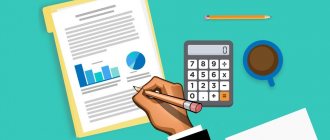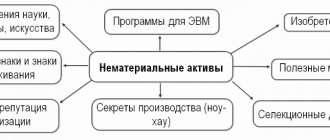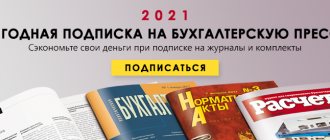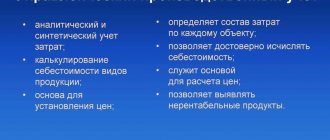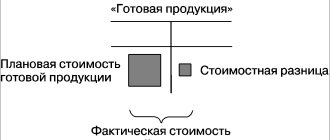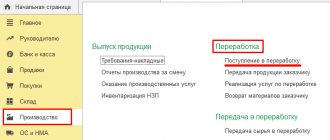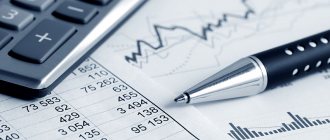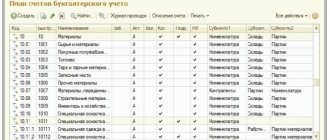What is account 20 in accounting
Account 20 is one of the registers in Section III of the Chart of Accounts. It summarizes information about the costs associated with the production of products (works, services).
Expenses
The main function of account 20 “Main production” is calculation, since it describes the economic process of manufacturing a product and collects all information about the costs of its production. Also, using an account card, you can track information about the movement of property in the enterprise.
The difference between this register and the others in accounting is that its balance at the end of the reporting period is not calculated using a formula, but is entered manually. This is due to the fact that cost information is collected on the account over a period of time (at least a month). Until the end of the period, the exact cost of the goods is unknown, since it includes many components - depreciation, wages for workers and management, utilities, transportation costs.
Thus, at the end of the reporting period (and necessarily at the end of the year), the account. 20, like production shops, is subject to inventory to identify work in progress. After this, the amount spent on the production of finished products (actual cost) is calculated, which is written off using one of the methods adopted by the enterprise’s accounting policy.
Accounting for expenses of service industries and farms
Service industries and farms are those structural divisions of an enterprise that perform functions not directly related to the main activities of the enterprise. Such service industries and farms may include:
- objects of the social structure that are on the balance sheet of the enterprise (dormitories, kindergartens, clubs, clinics, hospitals, dispensaries, sanatoriums, etc.);
- farms for the production of products not related to the main activity of the enterprise (for example, a pig farm at a metallurgical enterprise - its products are used to provide meat for workshop canteens and social facilities of the enterprise).
The debit of account 29 is used to reflect direct expenses associated with the activities of service industries and farms. The credit of account 29 reflects the actual cost of products and services produced by service industries and farms.
IMPORTANT! Account 29 does not correspond with account 20, as follows from the Chart of Accounts and instructions to it, approved by Order of the Ministry of Finance dated October 31, 2000 No. 94n. This is explained by the fact that, according to the meaning of the transactions for which account 29 is provided, it should not reflect anything that could form the production cost of the types of main products produced.
What counts in the 20 count?
Account 20 is used to account for the following costs:
- production of products from agricultural and industrial enterprises, as well as subsidiary farms;
- costs of repair work, maintenance of cars and other vehicles;
- costs of organizations providing transport services;
- costs of construction, installation and design and survey work;
- costs of performing research and development work;
- costs of catering organizations;
- salaries of key and administrative personnel;
- depreciation of production equipment;
- amounts of payments for renting premises and paying for utilities;
- other expenses related to the activities of the production enterprise.
Debit 20 reflects all direct costs associated with the manufacture of products (performance of work and provision of services), costs of auxiliary production, indirect costs, as well as losses from defects. Credit 20 reflects the amount of the actual cost of goods, the production of which has already been completed, or work performed and services rendered.
Counting scheme 20
When determining the type of account 20 - whether it is active or passive - you need to understand the following: since the company cannot consume more raw materials and materials than it was written off for, therefore, debit turnover on the account. 20 will always be more credit. And this means that the count. 20 - active. Balance (remaining) according to account. 20 at the end of the month reflects the amount of work in progress costs.
Accounting for production costs when releasing products
The expenses of an enterprise engaged in the production of products are, as a rule, standardized. The company sets its own standards based on the technology used and economic and statistical calculations. If an enterprise does not have the opportunity to develop technologically sound standards, then standardization is carried out based on actual costs. In this case, the standard is usually taken as the average cost per unit of production. In order for the application of standards to be effective, established standards must be periodically analyzed, corrected, and supplemented.
To determine the planned and actual production costs, product cost calculations or cost calculations are compiled. In such calculations, the value of all types of direct and indirect costs per unit of production is established. Indirect costs are distributed in one of the following ways:
- by distributing indirect costs in proportion to material costs;
- by distributing indirect costs in proportion to the wages of key production personnel;
- distribution of indirect costs in proportion to production costs.
IMPORTANT! Expenses collected on account 26 may not be distributed to main production. In this case, accounting in the main production will be carried out at a reduced cost (direct production costs only). Then the amounts accumulated in the indirect costs account must be attributed directly to the cost of sales by posting Dt 90.2 Kt 26. Which method of accounting for production costs is chosen is necessarily recorded in the accounting policy of the enterprise.
Production costs include:
- materials for production;
- labor costs;
- costs for compulsory social insurance of production personnel;
- depreciation of production assets;
- other costs;
- costs of auxiliary production.
The cost items indicated above (except for the costs of auxiliary production), in accordance with clause 8 of PBU 10/99, form a grouping of expenses from ordinary activities by type of cost. The last point of the above classification may or may not be included in production costs by an enterprise. The adopted accounting method must be reflected in the accounting policy.
How to classify production cost items can be found here: “Classification of production cost items.”
How to close
Closing of account 20 occurs when the production of products is completed, work is performed or services are provided. To close the account, it is necessary to reflect it in the accounting entry for a loan for the amount of goods produced. Thus, after closing the account, it can either be reset to zero (if there are no other work in progress) or remain with a debit balance (if there is still work in progress).
Note! Account lending 20 does not always mean production is complete. If a defect is detected, it is also written off from credit 20 to debit 28 “Defects in production”.
Current legislation provides for the possibility of closing an account. 20 in one of three ways: direct, intermediate or direct implementation. The characteristics of the closing method must be spelled out in the accounting policy of the enterprise, and immediately before closing, the accountant must highlight the balances of work in progress, if any.
Direct method
This method is used when the actual price of manufactured products is unknown during the reporting period, so they are accounted for at conditional prices, mainly at planned costs. In the process of closing the account. 20 accounting department adjusts the cost of manufactured products to the actual cost.
With this closing method, accounting makes the following entries:
- Dt43 Kt20 - finished products are transferred to the warehouse at the planned cost;
- Dt90-02 Kt43 - writing off deviations of actual and planned cost to cost of sales.
Attention! When using this closing method, it becomes impossible to take into account the actual price of products during the month.
Intermediate method
When using this method, an account is additionally used in accounting. 40 “Product release”. This account reflects deviations of the planned cost from the actual one, while credit 40 includes the planned cost, and debit the actual cost.
Intermediate method of closing an account. 20
At the end of the reporting period, the total amount of the difference is written off proportionally to the account. 43 and 90-02. During the month, the accountant makes the following entries:
- Dt43 Kt40 - capitalization of finished products at planned cost;
- Dt90-02 Kt43 - write-off of sold products at planned cost.
How to close account 20 at the end of the month:
- Dt40 Kt20 - write-off of the actual cost of manufactured products;
- Dt43 Kt40 and Dt90-02 Kt40 are adjusting entries that bring the planned cost to the actual cost.
Direct implementation
This method of closing an account. 20 applies when the manufactured goods are not stored in a warehouse, but are immediately sold by the buyer. In this case, the costs are immediately written off to the cost of sales - Dt90-02 Kt20.
Results
The production cost of products is formed on the 20th account. General production and general business expenses:
- are allocated to production costs in proportion to one of three indicators: material costs, wages and direct production costs of products, if the accounting policy provides for accounting at full production costs;
- are charged to the cost of sales (debit of account 90), if the accounting policy establishes accounting at a reduced cost.
Service industries and farms, the costs of which are formed on the 29th account, have no relation to the main production. Auxiliary shops of the main production can both sell products (provide services) to other divisions within the enterprise, and sell part of the products (work, services) to the outside.
The production cost of finished products is formed on the 40th or 43rd account.
You can find more complete information on the topic in ConsultantPlus. Free trial access to the system for 2 days.
Subaccounts
For account 20 the following recommended sub-accounts can be opened for the main activities of the enterprise:
- 20-01 “Crop production”. This takes into account the costs of crop production and its branches - horticulture, floriculture, growing seedlings.
- 20-02 “Livestock” - accounting for the costs of output from livestock farming and its industries - dairy and beef cattle breeding, sheep farming, fish farming, beekeeping, etc.
- 20-03 “Industrial production”. This subaccount reflects all direct costs associated with the manufacture of goods, preparation and development of production, other production costs, as well as production maintenance and management costs.
- 20-04 “Other main production” - cost accounting for other main activities of manufacturing enterprises.
Manufacturing Cost Accounting: Example
Let's look at an example.
1. Technological standards establish that the production of one set of linen requires:
- 8.5 m of calico at a price of 110 rubles/linear. m;
- 2 spools of sewing thread, 200 m each, priced at RUB 14/spool;
- 12 m of cotton stitching at a price of 50 rubles/m.
All prices are excluding VAT.
2. The production rate of workshop No. 1 for sets of bed linen per month is 1,000 pieces.
In the first sewing workshop, where the production of these sets is planned, 4 seamstresses work. The production norm for one seamstress is 250 sets.
3. The salary of one seamstress per month is set at 15,000 rubles.
4. Payroll charges: PFR - 22%, FSS for temporary disability and maternity - 2.9%, FFOMS - 5.1%, FSS for injuries - 0.4%. Total payroll accruals - 30.4%
ATTENTION! On July 11, OKVED-2 (OK 029-2014, NACE rev. 2) came into force, but occupational risk classes are still tied to OKVED-1. In accordance with OKVED-2, the production of such garments as bed linen belongs to class 13. According to OKVED-1, this type of activity is related to class 18 - production of garments - and has a 3rd class of professional risk with a rate of 0 ,4%. Starting from 2021, this discrepancy will be eliminated by legislators, but do not forget to submit to the Social Insurance Fund information about the main type of activity for 2021 by April 1, indicating the new OKVED-2 code (according to OK 029-2014).
5. The payroll for the second sewing workshop is 250,000 rubles. per month.
6. Auxiliary production - sewing machine adjuster. Works for two sewing shops. The adjuster's salary is 25,000 rubles/month.
7. The salary of the master of the first sewing workshop is 17,000 rubles/month.
8. Shop No. 1’s electricity costs are 1,200 rubles/month. (without VAT). An electricity consumption meter is installed in the workshop.
9. Heating costs for the entire building of production workshops - 35,000 rubles/month. Excluding VAT.
10. Depreciation of equipment installed in workshop No. 1 - 4,500 rubles/month.
11. Other production costs of the 1st workshop - 12,500 rubles/month.
12. Administrative expenses - 685,000 rubles/month.
13. Sales expenses - 140,000 rubles. /month
14. According to the accounting policy, finished products are accounted for at full cost. General production and general business expenses are distributed in proportion to the wages of production workers.
The kits were produced in December 2021. All products were sold in December.
Let's calculate:
- Production cost of 1 set.
- Production costs of the 1st sewing workshop for December.
- The full cost of 1 set of linen.
Table 1. Production cost per unit of production.
| No. | Costing items | Calculation | Quantity per unit | Price per one. change | Amount, rub./set |
| 1 | Plain dyed cotton calico | 8,5 × 110 = 935 | 8,5 | 110 | 935,00 |
| 2 | Cotton sewing threads | 2 × 14 = 28 | 2 | 14 | 28,00 |
| 3 | Cotton machine stitching | 12 × 50 = 600 | 12 | 50 | 600,00 |
| 4 | Seamstress salary | 15,000 / 250 sets = 60 rub./set. | 60,00 | ||
| 5 | Foreman's salary | 17,000 / 1,000 sets. = 17 RUR/set. | 17,00 | ||
| 6 | Social security contributions | (60 + 17) × 0,304 = 23,41 | 23,41 | ||
| 7 | Electricity | 1200 / 1 000 = 1,20 | 1,20 | ||
| 8 | Depreciation | 4 500 / 1 000 = 4,50 | 4,50 | ||
| 9 | other expenses | 12 500 / 1 000 = 12,50 | 12,5 | ||
| Total production cost per unit of production | 1 681,61 |
Thus, the production cost of one set of bed linen was 1,681.61 rubles.
Table 2. Production costs of workshop No. 1 for December.
| No. | Grouping costs by element | Quantity per volume | Price per one. change | Amount, rub./set |
| 1 | Material costs | |||
| 1.1 | Plain dyed cotton calico | 8,5 × 1 000 = 8 500 | 110 | 935 000,00 |
| 1.2 | Cotton sewing threads | 2 × 1 000 = 2 000 | 14 | 28 000,00 |
| 1.3 | Cotton machine stitching white | 12 × 1 000 = 12 000 | 50 | 600 000,00 |
| 2 | Payroll of the workshop | 15 000 × 4 + 17 000 = 77 000 | 77 000,00 | |
| 3 | Payroll accruals | 77 000 × 0,304 = 23 408 | 23 408,00 | |
| 4 | Electricity | 1 200,00 | ||
| 5 | Depreciation | 4 500,00 | ||
| 6 | other expenses | 12 500,00 | ||
| Total production cost of volume | 1 681 608,00 |
Table 3. Total unit cost of production of sewing shop No. 1 for December
| No. | Grouping costs by element | Calculation per unit | Amount, rub./set |
| 1 | Material costs | pp. 1–3 tables 1: 935 + 28 + 600 = | 1 563,00 |
| 2 | Labor costs for key production personnel | item 4 table. 1 | 77,00 |
| 3 | Payroll accruals | item 5 table. 1 | 23,41 |
| 4 | Electricity | item 6 table. 1 | 1,20 |
| 5 | Depreciation | item 7 table. 1 | 4,50 |
| 6 | Other expenses of workshop No. 1 | item 8 of table 1 | 12,50 |
| Total production cost | 1 681,61 | ||
| 7 | Workshop heating costs | 35 000 × 77 000 / (77 000 + 250 000) / 1000 = 35 000 × 0,24 / 1 000 = | 8,24 |
| 8 | Support staff salaries | 25 000 × 77 000 / (77 000+250 000) / 1 000 = 25 000 × 0,24 / 1 000 = | 5,89 |
| 9 | Payroll accruals for support staff | 25 000 × 0,304 × 0,24 / 1 000 = | 1,82 |
| Total costs including overhead costs per unit of production | 1 697,56 | ||
| 10 | Administrative expenses | 685 000 × 0,24 / 1 000 = | 161,30 |
| 11 | Sales costs | 140 000 × 0,24 / 1 000 = | 32,97 |
| Total total cost per unit of production | 1 891,83 |
We will allocate expenses to main production and write off production expenses to the cost of products sold.
Table 4. Write-off of production costs
| Dt | CT | Amount, rub. | Operation description | Source documents |
| 20 | 10 | 1 563 000 (935 000 + 28 000 + 600 000) | Write-off of materials for production | Requirement-invoice, limit-fence cards |
| 20 | 70.1 | 77 000 | OPP salary | Payroll statement |
| 20 | 69 | 23 408 | Payroll accruals | Accountant's calculation |
| 20 | 60 | 1 200 | Electricity | Electricity delivery certificate for December from the energy supply company |
| 20 | 02 | 4 500 | Depreciation | Help-calculation |
| 20 | 76, 60 | 12 500 | other expenses | Agreements, acts, invoices |
| 20 | 26 | 8 240 | Heating | Help-calculation |
| 20 | 23 | 5 890 | Salary of the auxiliary workshop | Help-calculation |
| 20 | 23 | 1 820 | Payroll accruals | Help-calculation |
| 20 | 26 | 194 270,0 | Sales and administrative expenses are written off to the cost of finished products. | Help-calculation |
| 43 (40) | 20 | 1 891 828,00 | Finished products accepted for accounting | Help-calculation |
The cost of finished products released from the main production and sold in December amounted to RUB 1,891,828.00.
Interaction with other accounts
Account correspondence 20 on debit is carried out with the following sections:
- Section 1 - 02, 04, 08.
- Section 2 - 10, 11, 16.
- Section 3 - 20, 21, 23, 25, 26, 28, 29-3.
- Section 4 - 40, 41, 43.
- Section 6 - 60, 68, 69, 70, 71, 73, 75, 76, 79.
- Section 8 - 94, 96.
On loan account 20 interaction with other accounts is carried out as follows:
- Section 2 - 1, 11.
- Section 3 - 21, 28.
- Section 4 - 40, 43.
- Section 6 - 76, 79.
- Section 8 - 90, 91, 94, 99.
Account postings 20
All transactions performed under debit 20 show the accrual, reflection and accounting of the cost of all materials and costs of manufacturing products.
Typical wiring
The correspondence with Section 1 reflects the inclusion of depreciation costs in the cost of production:
- Dt20 Kt02 - for products used in primary production and trade;
- Dt20 Kt04 - for depreciation of intangible assets;
- Dt20 Kt08 - construction costs are reflected.
Correspondence with Section 2 reflects the write-off of the cost of materials:
- Dt20 Kt10 - the cost of materials written off for main production is taken into account;
- Dt20 Kt11 - write-off of the cost of animals for the main production is taken into account;
- Dt20 Kt16 - writing off the amount of deviations in the cost of materials.
The correspondence with Section 3 reflects the inclusion in the cost of other types of expenses:
- Dt20 Kt20 - intra-production turnover of products;
- Dt20 Kt21 - transfer of self-made semi-finished products to the main production;
- Dt20 Kt23 - inclusion in the cost price of the cost of services of auxiliary production;
- Dt20 Kt25 - inclusion of overhead costs in the cost of production;
- Dt20 Kt26 - inclusion of general business expenses in the cost of production;
- Dt20 Kt28 - inclusion in the cost of losses from defects;
- Dt20 Kt29 - inclusion in the cost of production the cost of services of service industries and farms.
Correspondence with Section 4 occurs as follows:
- Dt20 Kt40 - write-off of planned cost;
- Dt20 Kt41 - transfer to the main production of goods purchased for sale;
- Dt20 Kt43 - supply of finished products for the needs of the main production.
Correspondence with Section 6 occurs as follows:
- Dt20 Kt60 - payment to third parties for services provided for the main production;
- Dt20 Kt68 - inclusion of taxes and fees in the budget in the cost of production;
- Dt20 Kt69 - calculation of insurance premiums for employees of the main production;
- Dt20 Kt70 - payroll;
- Dt20 Kt71 - payment of expenses of accountable persons for the needs of the main production;
- Dt20 Kt73 - inclusion of compensation for wear and tear of personal property in the cost of production;
- Dt20 Kt75 - contribution of the main production costs by the founders of the enterprise;
- Dt20 Kt76 - inclusion of insurance costs in the cost price;
- Dt20 Kt79 - inclusion of separate production costs in the cost price.
Correspondence with Section 8 occurs as follows:
- Dt20 Kt94 - inclusion in the cost price of the amount of identified shortages for various reasons (from damage to property, based on inventory results);
- Dt20 Kt96 - accrual from the cost of production of amounts to the reserve for future expenses (for repairs, vacation pay).
Note! Entries for credit 20 reflect the receipt of materials, waste, and finished products from the main production.
The relationship with Section 2 reflects the return of materials and supplies from main production:
- Dt10 Kt20 - taking into account unused materials and waste.
- Dt11 Kt20 - increase in the cost of animals due to weight gain.
Correspondence with Section 3 accounts occurs as follows:
- Dt21 Kt20 - receipt of self-made semi-finished products from the main production;
- Dt28 Kt20 - reflection of losses in the cost of irreparable defective products.
Correspondence with Section 4 accounts:
- Dt40 Kt20 - write-off of the actual cost of manufactured products;
- Dt43 Kt20 - posting of finished products.
Capitalization of finished products
The relationship with the accounts of Section 6 reflects:
- Dt76 Kt20 - reduction in the cost of work in progress;
- Dt79 Kt20 - performance of work by the main production.
Correspondence with Section 8 occurs as follows:
- Dt90 Kt20 - write-off of actual cost;
- Dt91 Kt20 - write-off of works or services of the main production;
- Dt94 Kt20 - reflection of the amounts of shortage of work in progress identified during the inventory process;
- Dt99 Kt20 - the costs of the main production are attributed to the losses of the enterprise.
Accounting for expenses of auxiliary production
Account 23 “Auxiliary production” accumulates information about expenses in the divisions of the enterprise that are classified as auxiliary. These divisions include:
- transport workshops (at enterprises that are not transport companies);
- repair shops;
- tool workshops, workshops for the production of tools and equipment, processing shops;
- units for the construction of non-title (temporary) structures;
- divisions for the extraction of non-metallic materials (stone, gravel, sand);
- logging and sawmill divisions;
- workshops for processing agricultural products (as part of agricultural enterprises whose main activity is growing, rather than processing agricultural products).
The debit of account 23 reflects the formation of direct costs. The indirect costs of managing and maintaining auxiliary workshops are also written off to the debit of account 23 from the credit of accounts 25 and 26. If the technological cycle and accounting system at the enterprise allows, then the costs of servicing and managing auxiliary production can also be collected directly on account 23.
Posting Dt 20 Kt 23 reflects the release of work, services, products produced by auxiliary shops to the main production of the enterprise. If products and services of auxiliary production are sold to service farms, then posting DT 29 Kt 23 is used.
Auxiliary workshops can provide services and produce products intended for third parties. In this case, to write off the cost generated according to Dt 23, the following posting is relevant: Dt 90 Kt 23.
The analysis of expenses is carried out in the context of various auxiliary productions, therefore, for analytical accounting, subaccounts of the 23rd account are opened for the types of auxiliary workshops. The balance of account 23 shows the cost of work in progress in auxiliary departments.
